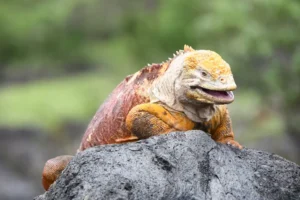Fernandina is one of the most beautiful islands in the Galapagos Archipelago. The island is 247.87 square mile in size and boasts an active volcano rising 4842 miles above the sea level. The volcano’s crater is 4 miles wide. Fernandina, the youngest island of the archipelago has unique ecosystems that are not found anywhere else on Earth.
A Haven for Wildlife

©Galápagos Conservancy
Fernandina is a wildlife refuge despite being home to the most active volcano in the world. The island is home to a diverse range of wildlife including land and marine Iguanas, fur seals and penguins as well as endemic species like mockingbirds and finches. Fernandina also has breathtaking landscapes, unique ecosystems, and a story which fascinates scientists and nature lovers worldwide.
Discovering the Giant Tortoise of Fernandina
The scientific community was stunned in 2019 when the living Fernandina tortoise Fernanda was discovered. The discovery of this tortoise as the last individual of its kind, Chelonoidis Phantomasticus has reignited the hope for the conservation of an endangered species. The discovery of this tortoise was significant and extraordinary, inspiring conservationists around the world to act to protect endangered species.
Fernandina Conservation: Challenges and Commitments
Fernanda’s story is even more poignant because despite numerous expeditions another individual has not been found. The Giant Tortoise Rearing and Breeding Center is located on Santa Cruz Island. It reminds us of the fragility and importance of protecting the Galapagos Archipelago’s natural treasures.
Fernandina is a place of special beauty where science and conservation meet to preserve a natural treasure. This effort also provides an unforgettable experience for scientists and park rangers, challenging them to do their best in protecting our planet’s biodiversity.

©Galápagos Conservancy

©Jorge Carrión / Galápagos Conservancy
Dr. Jorge Carrion is the Director of Conservation for Galapagos Conservancy. He highlights the importance of the efforts and dedication of the rangers of the Galapagos National Park Directorate. Their commitment to long-term preservation of Fernandina’s unique nature remains undiminished.
The fight for conservation is now more important than ever. We can only do this if we want future generations to be able to enjoy the natural beauty of Fernandina.

©Jorge Carrión / Galápagos Conservancy



